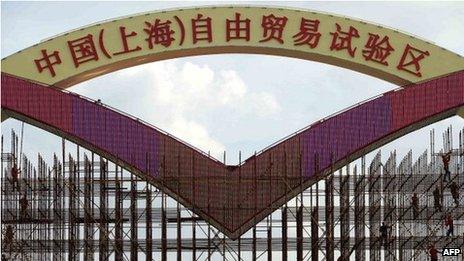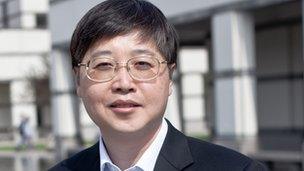Shanghai's free trade zone raises hopes
- Published

The sign marks the "Shanghai Pilot Free Trade Zone"
To look at it you wouldn't think the future of the world's second largest economy depended on it.
The 10-sq-km block in the eastern suburbs of Shanghai currently contains a few bonded warehouses, some factories and the odd patch of open scrubland.
But the brand new sign, with the words "Shanghai Pilot Free Trade Zone" written on a yellow and red steel archway over the access highway, is causing quite a stir nonetheless.
The plan, which has some powerful backers including China's Prime Minister, Li Keqiang, is being seen as deeply significant - a sign that the country's leadership is preparing to test out important, and long awaited, economic reforms.
Some are already drawing parallels with China's great architect of economic transformation, Deng Xiaoping.
"There is a lot of resistance towards reform, especially in the financial sector," Xu Bin, professor of economics and finance at the China Europe International Business School (CEIBS), tells me.
"So Li Keqiang is learning from Deng Xiaoping. He wants to start from a small area as a breakthrough, so he picked Shanghai. Symbolically speaking, it is very, very significant."
'High level openness'
Free trade zones are not new to China.
In fact, the bonded warehouses and the factories mentioned are already part of the existing Waigaoqiao Free Trade Zone which offers customs benefits to manufacturers and traders.
But it is the backing of China's State Council, the country's cabinet, with the recent suspension of certain laws relating to foreign investors that signals something different is about to take shape in Shanghai.
In fact, four existing bonded zones - Waigaoqiao Free Trade Zone, Waigaoqiao Free Trade Logistics Park, Yangshan Free Trade Port Area and Pudong Airport Free Trade Zone - will all find themselves inside the new pilot zone.
Haibin Zhu, chief China economist at JPMorgan, also believes that the new combined, 28-sq-km area will be about so much more than just tax breaks for imports and exports.
"The free trade zone is about a more high level openness and reform," he says.
"So it includes at least four areas. One is the traditional trade openness, but also on top of that there is investment reform, administrative reform and financial reform.
"The core part," he adds, "is how to redefine the relationship between the government and the markets."

The existing Yangshan Free Trade Port Area will be included in the new zone
Opening up
Draft plans have been circulating suggesting that in redefining that relationship, the government is preparing to step aside, lightening the heavy regulatory load it places on the financial sector.
Banks inside the zone may be given more freedom over interest rates.
Limits may be lifted on currency exchanges.
And foreign investors may be allowed access to industries that are heavily protected in the rest of China, like telecommunications.
All of these are steps that liberal reformers, both inside and outside of China, have long been urging the government to take.
But in reality it has not been easy.
In the face of powerful vested interests the momentum of Deng Xiaoping's economic opening up, launched 30 years ago, has slowed, even slipped backwards a little some might argue.
Testing ground

Prof Xu Bin says there is a lot of resistance towards reform in China, especially in the financial sector
The idea of allowing Chinese people to freely swap their yuan for dollars, for example, terrifies the state-controlled banks, because large sums of capital would quickly flow abroad in search of more favourable returns in overseas wealth products.
And overseas-based speculative investors may send large sums of money in the other direction with unpredictable, destabilising effect.
But now, if it lives up to its billing, the Chinese leadership will have a testing ground in the new Shanghai Free Trade Zone.
"If you understand China you know that it is impossible to push a radical policy at the national level," Prof Xu Bin from CEIBS tells me.
It is worth noting, however, that there are, so far, very few concrete details about exactly what will, or won't be allowed in the zone, and what the likely timetable for the roll-out of any reforms might be.
Raised hopes
Perhaps, in practice, it may turn out to be little more than a symbolic gesture, the appearance of doing something, while simply further postponing the real and painful country-wide economic reform that so many believe is so necessary.
Much will depend on how strong a firewall is set up between the zone and Greater China.
The point is to keep the reforms limited and contained of course, but if there are no spillover advantages for businesses on the outside then the experiment may well prove meaningless.
But hopes are being raised.
On one small patch of China it looks like trade, investment and money are all about to start flowing a bit more freely and that will be welcome news for many observers.
If it isn't the long awaited great leap forward, it is at least a start.
- Published25 September 2013
- Published9 September 2013